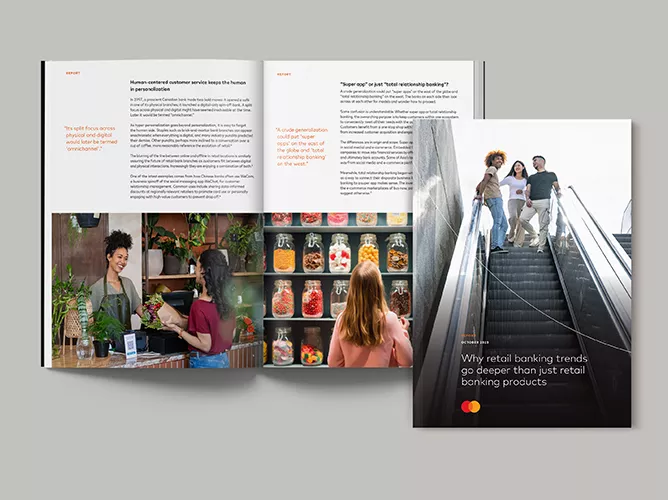By: Becky Goudy, Katheryn Stanwick and Meena Raman
Published: September 25, 2024 | Updated: September 25, 2024
Read time: 11 minutes
- Table of contents
What is product innovation?
Product innovation is the process of developing or enhancing products to better address customer needs. This process can result in new products to help fill a gap in the market, or the addition of new functionality or features to existing products to improve the customer experience.
Consumers are constantly evolving, and keeping a pulse on their needs is the basis of effective product innovation. Consider a beverage product and the endless ways it can be refreshed and improved. More sustainable packaging? Different flavors? Better health benefits?
Product innovation best practices can help businesses stay competitive. By offering new, innovative products with distinct benefits and value, businesses can increase customer satisfaction, drive repeat purchases and foster lasting customer relationships and loyalty. Product innovation can also help businesses support environmental, social and governance (ESG) goals, like reducing carbon footprints, improving health outcomes and increasing accessibility. Through this process, businesses can unlock new efficiencies in their supply chain and reduce costs, further boosting the bottom line.
What are the 4 Ps of product innovation?
An innovation strategy is a key ingredient to a business’s longevity and success. However, coming up with new products isn’t the only way to innovate. The 4Ps framework outlines the four ways businesses can approach innovation and drive growth:
- Product: Product innovation is often the first thing people think of when they consider innovation in a business context. Products — physical items, services, software and platforms — are an essential part of any business; it’s what you sell. Coming up with new, innovative products or improving existing products can help businesses address customer needs and stay ahead of the curve.
- Process: This type of innovation refers to adapting the operational process that leads to a product’s creation or delivery. For a physical good, such as a food item, an article of clothing or an electronic device, this could mean changing how the raw materials are sourced, how the product is manufactured or how it moves along the supply chain. Services and platforms can also undergo process innovation, like a delivery app finding a more efficient way to process and fulfill orders. Many quick-service restaurants are speeding up and personalizing the ordering process with the help of AI-powered drive-through assistants. Process innovation helps businesses unlock operational efficiencies and manage costs. It can also help meet ESG goals by producing products that are more energy efficient.
- Positioning: Evolving positioning means taking an existing product and shifting the way it is perceived and used, often by changing or broadening its target audience. For example, a travel operator that caters to leisure travelers may adapt their positioning to better engage business travelers, or a high-end fashion label may launch a mid-tier clothing line to make its brand more accessible to consumers. Positioning innovation is critical for business growth; over half of retailers say expanding into new markets is a top strategic priority.
- Paradigm: A paradigm is a distinct set of concepts or patterns. Paradigm innovation goes beyond other types of innovation and can change the fundamental business model. A common example of paradigm innovation is how Netflix’s business model evolved. The company started by renting DVDs to customers through direct mail. Then, as technology advanced and consumer expectations evolved, it transformed into a fully online streaming service and later a TV and film production company.
3 examples of product innovation
Examples of product innovation unfold in front of our eyes every day, in every industry. Many of them can be seen in our own homes.
Eliminating a common challenge
Think about the tools you use to complete your daily tasks, like cooking. OXO, a home goods manufacturer, developed angled measuring cups that allow the user to read measurements by looking down into the cup. It’s a simple fix to a common problem, helping people measure and cook more easily rather than needing to bend down to see the measurement lines.
Improving the health of consumers and the environment
Innovation is also omnipresent in the things we consume. CPG brands like Beyond Meat have revolutionized the food industry, for instance. By offering plant-based proteins that taste indistinguishable from animal meat, Beyond Meat helps consumers enjoy their favorite meals, like burgers and steaks, with added health and environmental benefits. Many brands are also repackaging products to be more sustainable. Boxed Water is 100% recyclable and helps eliminate plastic waste. Biodegradable and compostable packaging are also gaining steam.
Simplifying how consumers live their lives
Product innovation has also helped remove friction from day-to-day errands. The launch of Amazon’s Echo revolutionized how people complete simple tasks by letting them use their voice to make calls, check the weather or add items to their Amazon cart. As disruptive technologies like voice and artificial intelligence gain momentum, they can help businesses accelerate innovation and develop novel product concepts.
Product innovation best practices likely helped these businesses create long-lasting, impactful products.
How to come up with innovative product ideas
Ideation, or coming up with new ideas, is the basis of any product innovation process — but waiting for inspiration to strike can lead to missed opportunities.
One strategy to come up with innovative product ideas is a human-centered approach, which will get you to your end goal in the quickest, least risky way. This approach brings humans to the center of product development, with the goal of addressing a human need or problem. Identifying your target customer is the essential first step.
Once you’ve considered your customer and their needs and pain points, it’s time to thoroughly examine the problem at hand — often referred to as “falling in love” with the problem. This process should result in a specific and actionable problem statement. This statement is a jumping off point. From there, you can brainstorm product innovations and enhancements that directly address the problem. Empathy with the customer is critical. Put yourself in their shoes and work to understand their mental models or how they view things.
There is no single “right way” to brainstorm. Consider scheduling different types of brainstorming sessions — structured and unstructured, individual and group — to get your mind working in different ways. There are many techniques that can help, including:
- Rapid ideation involves generating a large volume of ideas in a short period. Everyone in the group writes down as many ideas as they can within a set amount of time before any ideas are shared or discussed. This can help promote creative thinking by preventing premature attachment to a specific idea and removing any perceived group judgement.
- Brainwriting is a nonverbal method in which each participant independently writes down an idea relating to the problem statement and then passes their idea to the next person to build on it. By the end of the brainstorm, each idea has been expanded and iterated on, and the group can consider which ideas to pursue.
- Starbursting is a framework that can help teams once they have come up with some initial ideas. This method is oriented around a series of questions — often who, what, where, when, how and why. The approach can uncover new streams of thinking and help shape a product roadmap by prompting the group to answer a series of questions. For instance: Why would customers want this product? What would it cost? When is the right time to release it?
Coming up with new ideas can feel challenging at times. In these moments, remember that if you’re stuck on your initial idea, you may not be understanding the problem or customer well enough or exposing yourself to enough new concepts.
Best practices for innovating new products
Looking to launch new products? These 10 product innovation best practices can help you drive a fruitful brainstorming process and generate out-of-the-box ideas.
1. Adopt a human-centered approach. Product innovation should always be centered around human needs. This approach is referred to as “human-centered design.” Its premise is simple: to effectively brainstorm new product ideas, carefully consider the customer’s needs and goals. Understanding and empathizing with the underlying need is critical for building products that resonate with customers. A structured innovation methodology, like design thinking, can help ensure you innovate intentionally and keep customer needs the primary focus. This approach includes key stages, like ideation, prototyping and testing. By following this process, you will translate the human need into a compelling problem statement, then into a novel set of ideas, and finally into a robust test concept.
2. Get deep in understanding the problem. Human-centered design means placing humans at the center of problems. So, use qualitative research, like interviews and focus groups, to investigate and solve their challenges and real-world experiences. Attempting to address the problem head-on can be challenging, so break it down into smaller components. For example, you might be looking to enhance a mobile app. If you’ve received feedback that the app isn’t easy to use, consider the different possibilities. Can you reduce the number of steps to log in, improve the loading speed or simplify the user interface? To really meet their needs, do you even need some of the features that were designed in the first place?
3. Empathize with your customer. While the customer need is a key piece of the puzzle, best practice requires you to think about who your customer is more holistically. What are their likes and dislikes? Where and when do they spend? What type of media do they consume? Deeply understanding your target customer and their behavior — even if it doesn’t “relate” to this specific problem — will give you a more complete picture and help inform your product development process.
4. Avoid getting stuck on the first idea. Once you have defined your problem statement and understood your customer’s point of view, it ’s time to start brainstorming. The ideation phase can seem daunting, but by facilitating various types of brainstorming exercises, you can maximize collaboration and create opportunities for inspiration to strike. Often, you might head into a brainstorm with a preconceived notion of where you will land, but try not to get stuck on it. Your first idea is not always your best, so stay open to other ideas and perspectives.
5. Explore different ways of getting to a solution. To avoid becoming overly attached to an idea, purposefully consider other possibilities. Expose yourself to how other industries are approaching human needs and product innovation. By intentionally diverging from your favorite idea and then returning to it again, you can improve your initial concept. Remember that the broader your range of ideas, the better your chance of coming up with something brilliant.
6. Bring in the experts. As you begin to circle in on your product concept, make sure to validate it with a wide group of stakeholders. Allocate sufficient time and resources to conducting external research and meeting with subject matter experts (SMEs). A knowledgeable set of SMEs will help bring broader market context and ensure your idea is viable. As you bring together your group of experts, prioritize hearing from diverse perspectives to foster more collaboration and accelerate the innovation process.
7. Develop prototypes to test the concept. External experts will help provide authority on the topic. However, the final say should always lie with the customers. To test your idea, you’ll need to work on the product design and develop prototypes. Prototypes can take different forms — a physical artifact or mockup of a platform, for example — but they should always offer a realistic view of how the product works. Bringing the idea to life through prototyping will help you visualize the product before launching into full-scale product development. By showing it to a set of test users so they can interact with it, you can gather real-time feedback and iterate on and improve the product.
8. Maintain a continuous feedback loop. A successful product innovation process doesn’t end with the product launch. A steady stream of feedback is not only essential during the testing stage but also once the product has gone to market. Keep a pulse on how users are reacting to the product so that you can improve it and introduce product enhancements later on. This is essential for ensuring your product doesn’t become irrelevant or redundant as human needs and technology continue to evolve.
9. Use data to measure success. While innovation should always be rooted in creativity and collaboration, data is paramount. Along with gathering customer feedback, you should also collect and analyze data on the product’s overall performance in the market. Identify the metrics or key performance indicators (KPIs) for measuring the product’s performance, and then look at historical data to gather benchmarks. Product innovation is often measured based on adoption and impact on profits. The insights you gather here can also help inform marketing and positioning efforts and future product decisions.
10. Foster a culture of innovation. Remember that innovation isn’t a one-time thing. The right environment is critical for facilitating a successful innovation process and building novel products. Encourage collaboration by gathering input from different groups and ensuring diverse perspectives are heard. Innovation is seldom done alone, and leaders should instill this mindset in their teams. Fostering this type of culture takes time but will pay dividends in the long run.
How to measure product innovation
Product innovation best practices can help you go to market, but innovation doesn’t stop there. Establish a continuous feedback loop to help understand what customers like and don’t like and improve the product in future iterations.
It’s also important to gather data to quantify the product’s overall performance. The ultimate measure of a product’s success is its adoption and profitability. In other words, how many people are using it? And has it helped drive business growth?
Identifying specific, measurable metrics will help you evaluate performance. For example, to determine the adoption rate, consider looking at the product’s market penetration. This is a measure of how many target customers are using the product relative to the total estimated market for the product. To calculate market penetration, you will need to accurately market size the population of eligible customers. You can also compare your levels of market penetration to competitors’ levels to understand your product’s competitive standing.
While market penetration is a strong signal of adoption, your analysis shouldn’t stop there. You can also collect data on user engagement, which is a measure of how often people use or interact with the product, how long they use it for and how often they use it. People can buy or trial your product, but it’s only active usage that will ensure the product’s long-term success.
Finally, to understand the impact on your bottom line, look to analytics tools. These can help you isolate and quantify the incremental revenue generated from the product’s launch, cutting through any other noise.
Finding reliable metrics to measure product innovation is a key step in the process. Ultimately, all measures of success should be tied back to the customer problem or goal. In other words, did our product effectively address the underlying human need?

















